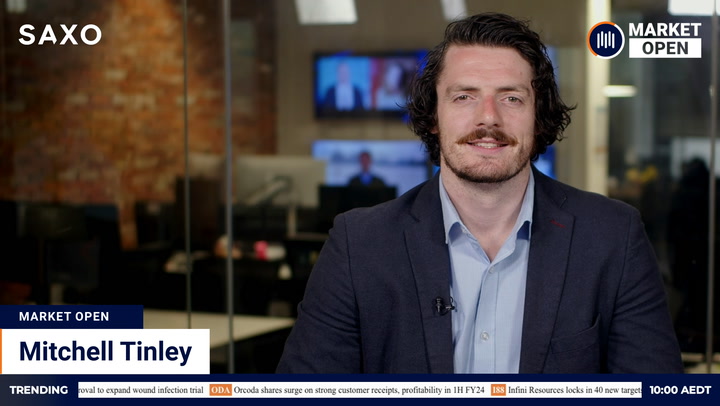The share market looked set for a flat start after a negative end to a wild night on Wall Street as US President Joe Biden banned Russian energy imports.
ASX futures inched up five points or 0.07 per cent. The S&P/ASX 200 closed at a five-week low yesterday amid fears surging commodity prices will stifle global growth.
Brent crude jumped almost 4 per cent overnight to a 14-year high. Gold traded near record territory. The London Metal Exchange suspended nickel trading after prices doubled. BHP and Rio Tinto declined as iron ore backed off a six-month high.
Wall Street
US stocks swung wildly overnight as investors weighed the White House’s Russian energy ban and the latest developments in Ukraine.
The Dow Jones Industrial Average finished 186 points or 0.57 per cent in the red after giving up a mid-session gain of 585 points. The S&P 500 shed 30 points or 0.73 per cent. The Nasdaq Composite lost 35 points or 0.28 per cent.
“There is a just a lot of uncertainty right now of what the impact is going to be on the U.S. economy,” James Ragan, director of wealth management research at DA Davidson, told Reuters.
“I think we will see a little pullback in the US consumer. Obviously, the gasoline prices are going to cause people to pause a little bit,” he added.
Energy providers rallied and crude prices rose after Biden banned Russian oil, gas and other energy imports. The president said the ban would “deal another powerful blow to Putin’s war machine”.
Russian President Vladimir Putin responded with a decree banning exports of Russian commodities. The decree gave the Russian cabinet two days to determine which commodities and countries would be on the list. Russia accounts for around 8 per cent of US petroleum imports, according to Bloomberg.
US gasoline and heating oil settled at record levels. Crude closed at its highest since 2008. Brent crude settled US$4.77 or 3.9 per cent ahead at US$127.98 a barrel. The US benchmark, West Texas Intermediate, rallied US$4.30 or 3.6 per cent to US$123.70.
“This is the tightest fundamental backdrop in years and the developments in Russia/Ukraine have ignited a market that was already a coiled spring,” Michael Tran, commodity analyst at RBC Capital Markets, wrote. “How high can oil prices go? Pick a number, this is a market in disarray.”
Trade was volatile as US stocks searched for a short-term bottom. On Monday, the Dow joined the S&P 500 in a technical correction, defined as a close more than ten per cent below a recent top. The Nasdaq entered a bear market after closing more than 20 per cent from last year’s high.
Australian outlook
Futures action suggests tentative relief for the ASX, but it would take a soothsayer to predict what comes after that. This morning’s headline numbers fail to capture the crazy intraday whipsaws on Wall Street and commodity markets. This is not a healthy market.
The S&P/ASX 200 fell 58 points or 0.86 per cent yesterday to a third straight loss and a five-week closing low. Defensive sectors outperformed as the market-leading energy sector took a breather. The overnight action in the US was a reverse image: energy outperformed, defensives tanked.
The energy sector rallied 1.39 per cent to be the night’s only significant winner. (Consumer discretionary edged up less than 0.1 per cent.)
Bond proxies declined as US yields rallied. Consumer staples shed 2.64 per cent, health 2.11 per cent and utilities 1.6 per cent.
The two sectors that matter most here, materials and financials, lost 0.5 and 0.55 per cent, respectively.
The market will get an insight into the Reserve Bank‘s latest thoughts on rates when Governor Philip Lowe addresses the Australian Financial Review Business Summit in Sydney at 9.15 am AEDT.
Monthly consumer sentiment figures were due at 11.30 am. China releases inflation data at 12.30 pm.
IPOs: the float of Catalano Seafood originally scheduled for today has been pushed back to Friday.
The dollar declined 0.8 per cent to 72.7 US cents.
Commodities
Gold closed near record levels as investors sought hedges against stagflation. Gold for April delivery settled US$47.40 or 2.4 per cent ahead at US$2,043.30 an ounce. Prices ran as high as US$2,078.80, within touching distance of the all-time intraday high of US$2,089.20 in 2020.
“The rally in gold has been accelerating since the Russia/Ukraine tensions began to escalate in earnest back in February, and renewed fears about stagflation are further supporting the gains,” analysts at Sevens Report Research wrote.
“With real rates dropping sharply from recent highs and market-based inflation expectations at new highs, the backdrop for gold is decidedly bullish.”
The NYSE Arca Gold Bugs Index of US precious metals miners gained 0.67 per cent.
Palladium topped US$3,000 an ounce before settling US$66.60 or 2.3 per cent higher at US$2,968.50.
The London Metal Exchange suspended nickel trading after prices more than doubled. Three-month nickel hit a record US$101,365 a tonne before trade was halted with the price up 66 per cent at US$80,000.
China’s Tsingshan Holding Group was reportedly facing a US$8 billion loss from short positions in the nickel market. Prices that normally move by a few percentage points a session have exploded since Russia’s invasion of Ukraine prompted boycotts of Russian production.
“This market is absolutely insane,” ING Senior Commodities Strategist Wenyu Yao said. “The fundamentals alone won’t be able to explain these prices.”
Benchmark aluminium on the LME skidded 6.01 per cent to US$3,515.20 a tonne. Copper eased 0.56 per cent. Lead gained 2.1 per cent, zinc 1.69 per cent and tin 4.1 per cent.
BHP and Rio Tinto fell in overseas trade as iron ore retreated from a six-month high. The spot price for ore landed in China eased 50 US cents or 0.3 per cent to US$162.25 a tonne. The most-traded ore contract on the Dalian Commodity Exchange declined 3 per cent.
BHP‘s US-traded depositary receipts dropped 3.89 per cent. The miner’s UK listing shed 2.78 per cent. Rio Tinto gave up 2.51 per cent in the US and 2.19 per cent in the UK.





